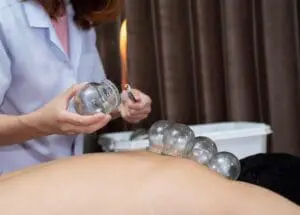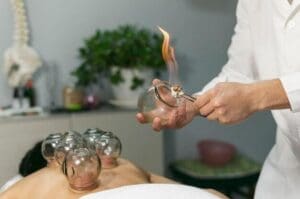Acupuncture for Preventing Complications after Hysterectomy
Cervical cancer, with an estimated 600,000 new cases diagnosed worldwide annually, ranks second in women’s malignant diseases. Accounting for one-third of the world’s total annual new cases, 83.9% of cervical cancer in China accepted surgical treatment.
The procedure is associated with significant perioperative morbidity, followed by some unavoidable complications. Bladder dysfunction (including sensory loss, incontinence, and urinary retention), lymphocyst formation, pelvic discomfort, ureterovaginal fistula, intestinal obstruction, and thromboembolic disease are the most common complications according to clinical practice and literature. Surgeons and other doctors try to reduce complications by careful postoperative management.
Bonafide Acupuncture is a holistic healing center specializing in acupuncture, Chinese herbal medicine, massage, and cupping therapy. With clinics located in Park Slope and Bay Ridge, Brooklyn, we offer patients a variety of treatment options based on Traditional Chinese Medicine to address chronic conditions and support overall wellness.
ACUPUNCTURE FOR PREVENTING COMPLICATIONS AFTER HYSTERECTOMY
We aimed to investigate the preventive effects of acupuncture for complications after radical hysterectomy. A single-center randomized, controlled, single-blinded trial was performed in a Western-style hospital in China. One hundred and twenty patients after radical hysterectomy were randomly allocated to two groups and started acupuncture from the sixth postoperative day for five consecutive days.
Main Outcomes of the Study
The main outcome measures were bladder function and the prevalence of postoperative complications. Compared with the control group, the treatment group reported significantly improved bladder function in terms of maximal cystometric capacity, first voiding desire, maximal flow rate, residual urine, and bladder compliance, and decreased bladder sensory loss, incontinence, and urinary retention on the fifteenth and thirtieth postoperative days.
Benefits of Early Acupuncture Intervention
The treatment group showed a significant advantage in the reduction of urinary tract infections on the thirtieth postoperative day. But no significant difference between groups was observed for lymphocyst formation. By improving postoperative bladder function, early intervention of acupuncture may provide a valuable alternative method to prevent bladder dysfunctional disorders and urinary tract infection after radical We aimed to investigate the preventive effects of acupuncture for complications after radical hysterectomy.
Cervical cancer, with an estimated 500,000 new cases diagnosed worldwide annually, ranks second in women’s malignant diseases. Accounted for one-third of the world’s total annual new cases, 83.9% of cervical cancer in China accepted surgical treatment.
The procedure is associated with significant perioperative morbidity, followed by some unavoidable complications. Bladder dysfunction (including sensory loss, incontinence, and urinary retention), lymphocyst formation, pelvic discomfort, ureterovaginal fistula, intestinal obstruction, and thromboembolic disease are the most common complications according to clinical practice and literature. Surgeons and other doctors try to reduce complications by careful postoperative management.

Thromboprophylaxis with heparin and lower extremity sequential compression devices considerably decreases the incidence of thromboembolic disease. Preservation of the superior vesical artery and blood supply to the distal ureter also decreases vesicovaginal and ureterovaginal fistula. The nodus and controversy are located in bladder dysfunction and lymphocyst formation. The severity of bladder dysfunction depends on the radicality of the procedure, while the extent of lymphadenectomy has an impact on the variation of lymphocyte formation.
Prolonged bladder drainage allows time for repair and adaptation following injury to autonomic innervation. But it may increase the urinary tract infection and fibrosis. Although it may reduce damage to dominated sensory or motor nerves, laparoscopic nerve-sparing has limited indications and may increase the possibility of uncontrollable tumors.
Complementary and alternative medicine, especially acupuncture, is commonly applied to prevent and treat complications after abdominal surgical procedures in Chinese hospitals. But few literatures are randomized controlled trial and published in English. In our previous study, acupuncture showed some effects in treating urinary retention. Refractory cases of urinary retention still occurred when we started acupuncture treatment two weeks later.
In order to evaluate the preventive effects of acupuncture for complications, we shifted forward to postoperative acupuncture intervention in the current study. Not only was bladder dysfunction observed, but other complications, such as lymphocyst formation, urinary tract infection, and wound infection, were also paid attention to.
This was a single-center, prospective, single-blinded, parallel-group, randomized controlled trial. The trial protocol strictly followed the principles of the Declaration of Helsinki (version 2008), and approval had been obtained from the Ethical Committee of Sun Yat-sen Memorial Hospital, Sun Yat-sen University. All participants were required to give written informed consent.
Both treatment and control groups accepted regular postoperative medication and nursing care. Two accredited acupuncturists had more than 8 years of acupuncture experience and clinical research training. The acupuncture intervention started on the 6th postoperative day, once a day, and for five consecutive days. Patients lay in a supine position when they were accepting treatment.
Stainless steel needles ( mm, Tianxie, Suzhou, China) were inserted into the acupoints with relevant depth and direction after 75% alcohol was prepped on the skin. Needles were manipulated to achieve “De Qi,” a sensation of numbness, distention, soreness, and heaviness on the acupoints. An electrical stimulator (G6805-I, Xinsheng, Qingdao, China) was put on the needles of bilateral SP6, ST28, and MS4 concomitantly and continuously for 30 minutes, with appropriate strength of slight vibration reported by patients. A continuous wave with a frequency of 4 Hz was selected.
This study was a single-blinded, parallel-group, randomized, controlled clinical trial. We aimed to evaluate the preventive effects of acupuncture for complications.
The parasympathetic fibers, together with hypogastric (sympathetic) nerves to form the pelvic plexus, arise from S3-S4 to form the pelvic nerves, which may be severed during the sectioning of the caudal parts of the rectouterine ligament and rectovaginal ligament. Furthermore, part of the pelvic plexus may be removed along with the paravaginal tissue surrounding the upper 1/3 vagina. The radical dissection will interrupt the automatic nerve supply to the bladder.
The urodynamic examination is an objective and validated assessment of bladder function, which will be attenuated after due to the above impairment. In this study, the urodynamic results showed bladder function in the treatment group was better than that in the control group on the 15th and 30th postoperative days. Bladder dysfunctional disorders in the treatment group, including bladder sensory loss, incontinence, and urinary retention, were less than those in the control group. Acupuncture could significantly improve postoperative bladder function and reduce bladder dysfunctional disorders. Some other research also indicated that acupuncture was helpful for the recovery of bladder dysfunctional disorders, including urinary incontinence and retention. The possible mechanism for bladder recovery is the nonselective effect of acupuncture stimulation (electrical/mechanical) at S2–S4, where the pelvic splanchnic nerves and pudendal nerve arise. Acupuncture has positive effects on the nerve regeneration process and provides an alternative treatment for nerve-injured patients. For the patients after, acupuncture may help with impaired nerve restoration and reconstruction, which are essential for preventing bladder dysfunction.
Another possible mechanism of acupuncture effect for bladder dysfunction lies in the regulation and balance of neurotransmitters, such as catecholamines. A newly released clinical experiment shows that acupuncture at ST36 and SP6 can regulate the secretion of catecholamines. Catecholamines have the physiological action to dominate smooth muscle relaxation through the β-2 receptor and contraction through the α-1 receptor.
The literature presented that 14.5% of patients were more than 4 weeks old after urethral catheterization. Prolonged catheterization increases the risk of urinary tract infection. In our study, the treatment group had a significant advantage in reducing urinary tract infections on the 30th postoperative day. All the patients with urinary tract infections in the control group on the 30th postoperative day were accompanied by urinary retention. Acupuncture for patients helps prevent urinary tract infections because of its effect on preventing urinary retention on the 30th postoperative day.
The incidence of lymphocyte formation ranks second in complications, according to our study and the previous literature. It can lead to lymphedema and infection subsequently due to interruption of efferent pelvic lymphatics. But acupuncture could not reduce lymphocyst formation in this study protocol. It does not necessarily mean that acupuncture therapy does not work. Maybe the length of treatment or other acupuncture interventions should be taken into consideration. Moxibustion, which is a therapeutic tool based on acupuncture theory, may be applicable to prevent or treat lymphocyst formation and lymphedema because of its effect in increasing deep body temperature.
Continuous improvements in procedures are beneficial to decrease other complications. In terms of ileus, ureterovaginal fistula, and wound infection, the incidences were rare, and no significant differences were presented between both groups in this study. The later multicenter research and improvement of acupuncture protocol should focus on the resolution of bladder dysfunction and lymphocyst formation. It must be said that we should also try to find the stable predictive factors of postoperative complications in order to avoid unnecessary acupuncture treatment and attach more importance to the patients who really need it.
Conclusion: by improving postoperative bladder function, early intervention of acupuncture may provide a valuable alternative method to prevent bladder dysfunctional disorders and urinary tract infections after radical hysterectomy. But acupuncture did not prevent lymphocyst formation according to this protocol.

Korean 5 Element Acupuncture
Many patients see benefits from our unique approach combiningKorean 5 element acupuncture. This specialized technique targets key acupuncture points on the hands and feet to restore balance and treat conditions in a holistic manner.
Medical Massage in Brooklyn
For muscle tension, pain, or injury, we offer therapeutic Swedish, deep tissue, and medical massage in Brooklyn. Our licensed massage therapists can help address issues like scar tissue, back pain, headaches, and more.
Post-Treatment Care
Additionally, our herbal formulas and lifestyle guidance help patients continue healing at home between treatments. With consistent management of diet, stress, and other lifestyle factors, optimal results are achieved.
If you’re suffering from a chronic health problem in Brooklyn, contact Bonafide Acupuncture today for a consultation. Our compassionate practitioners are here to support your journey to renewed wellness and vitality.


